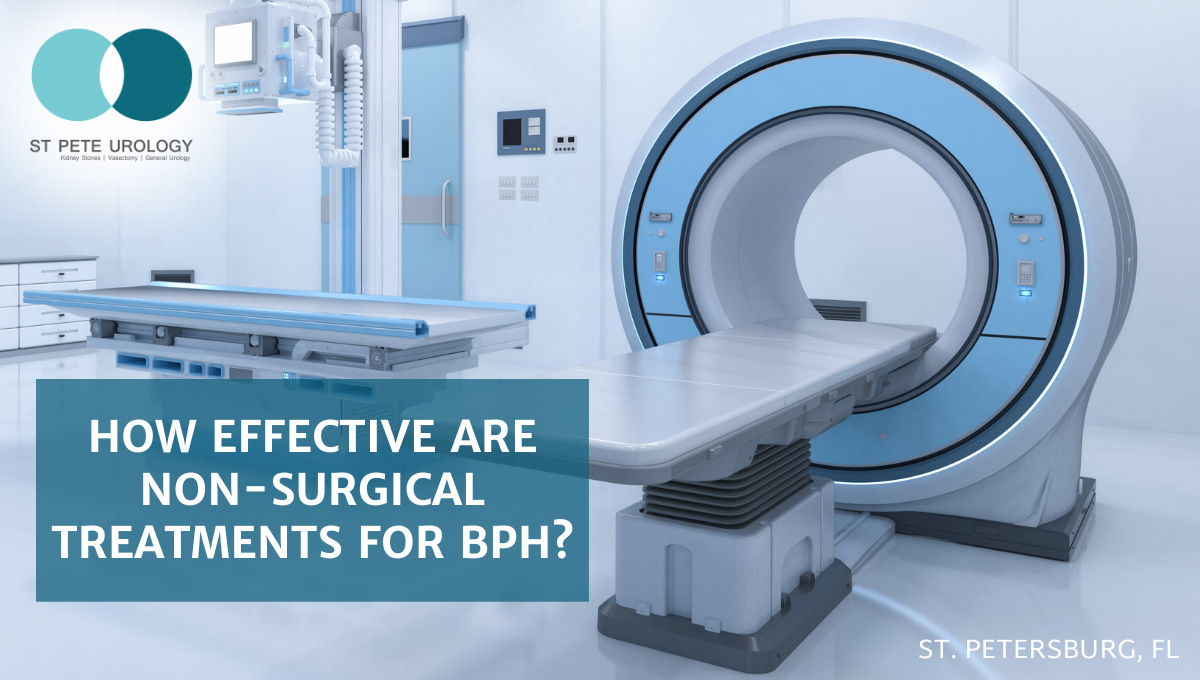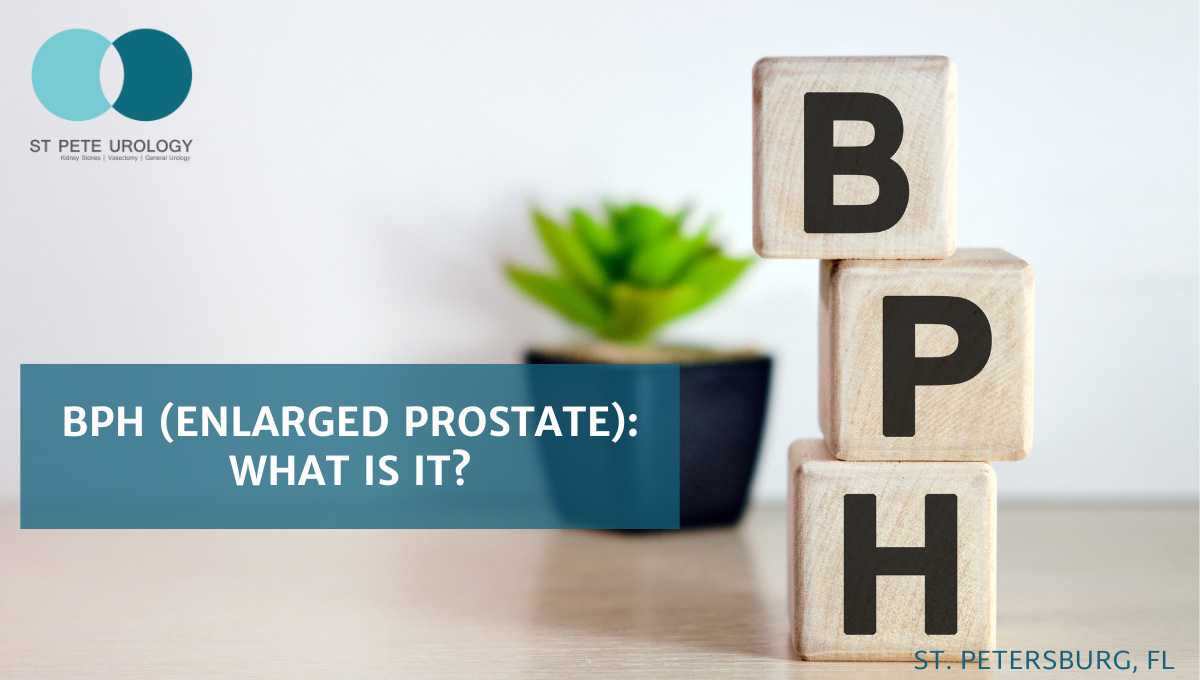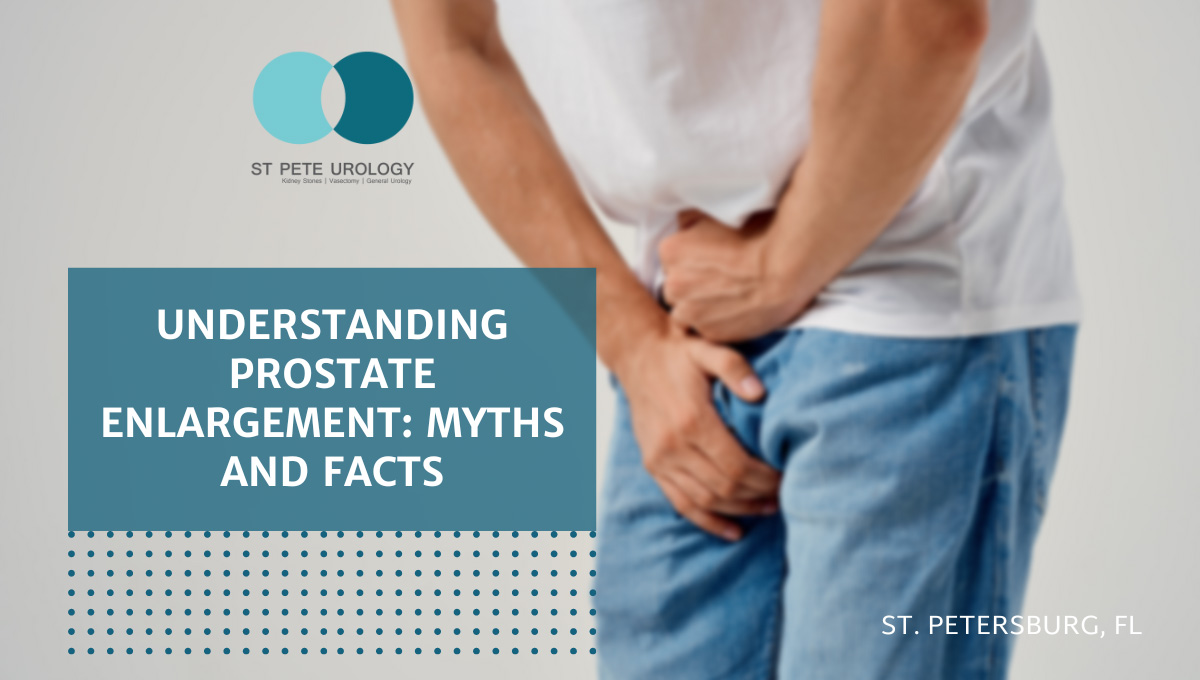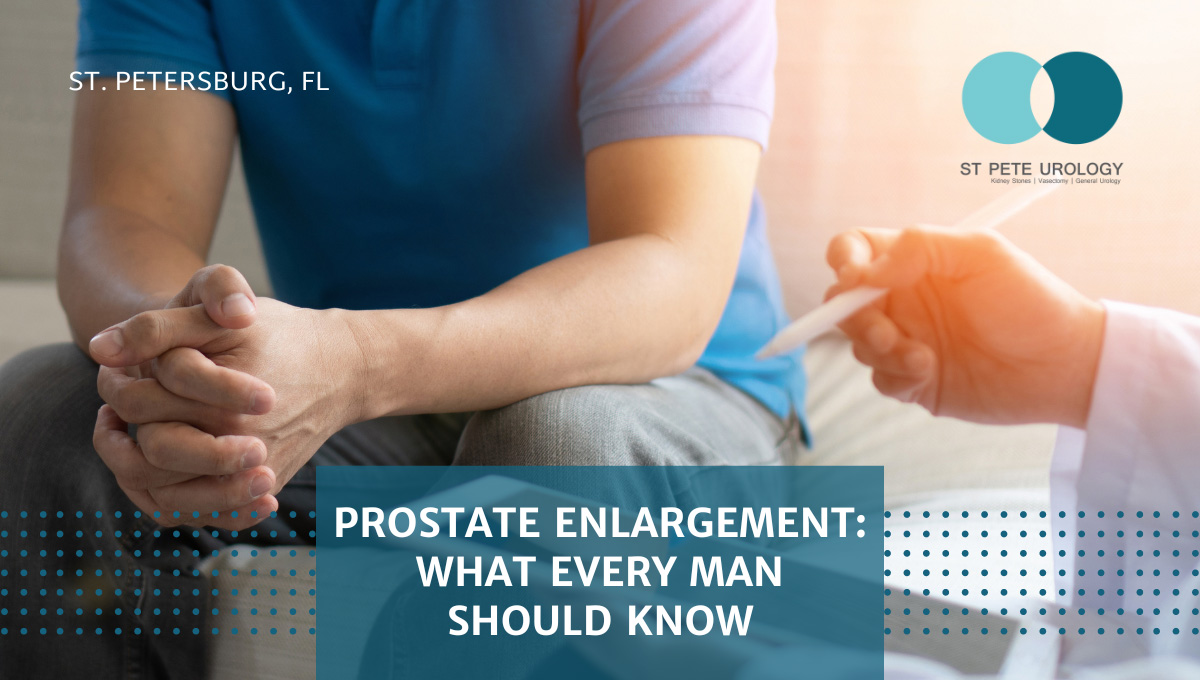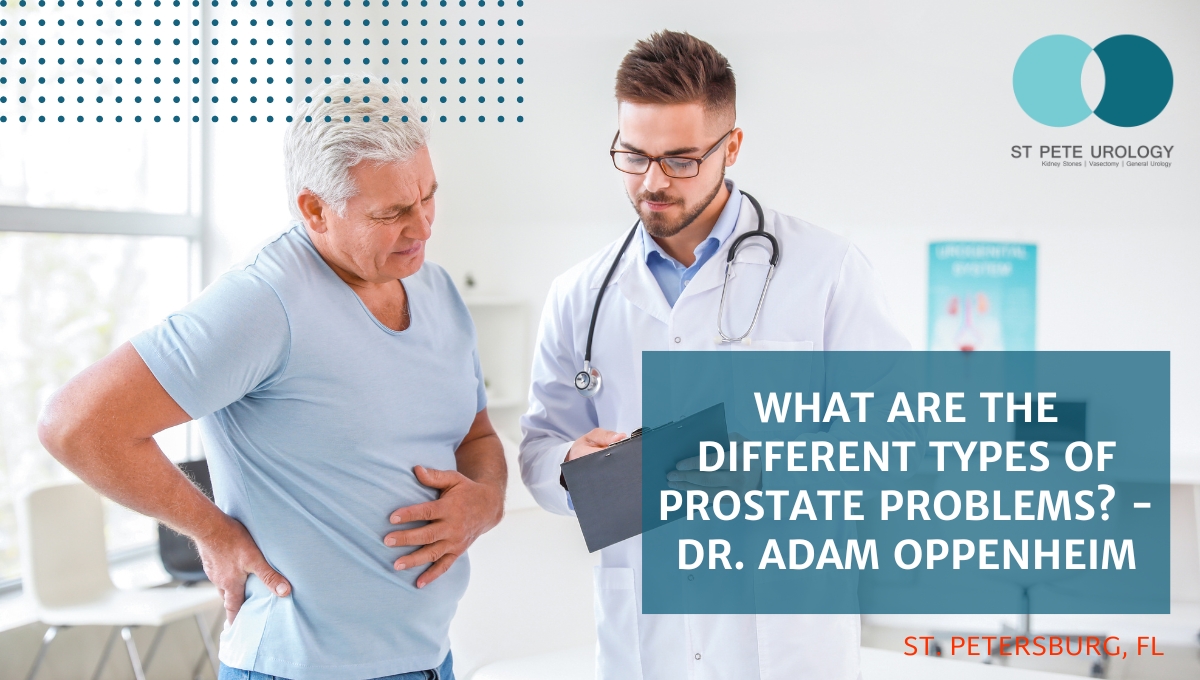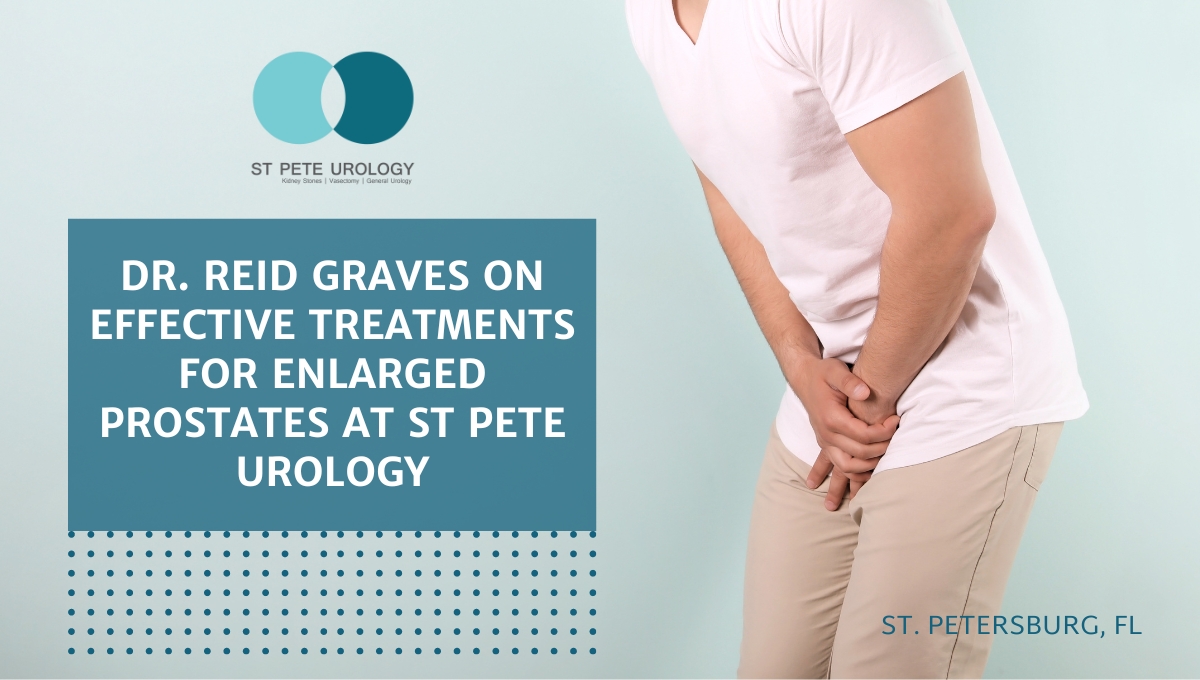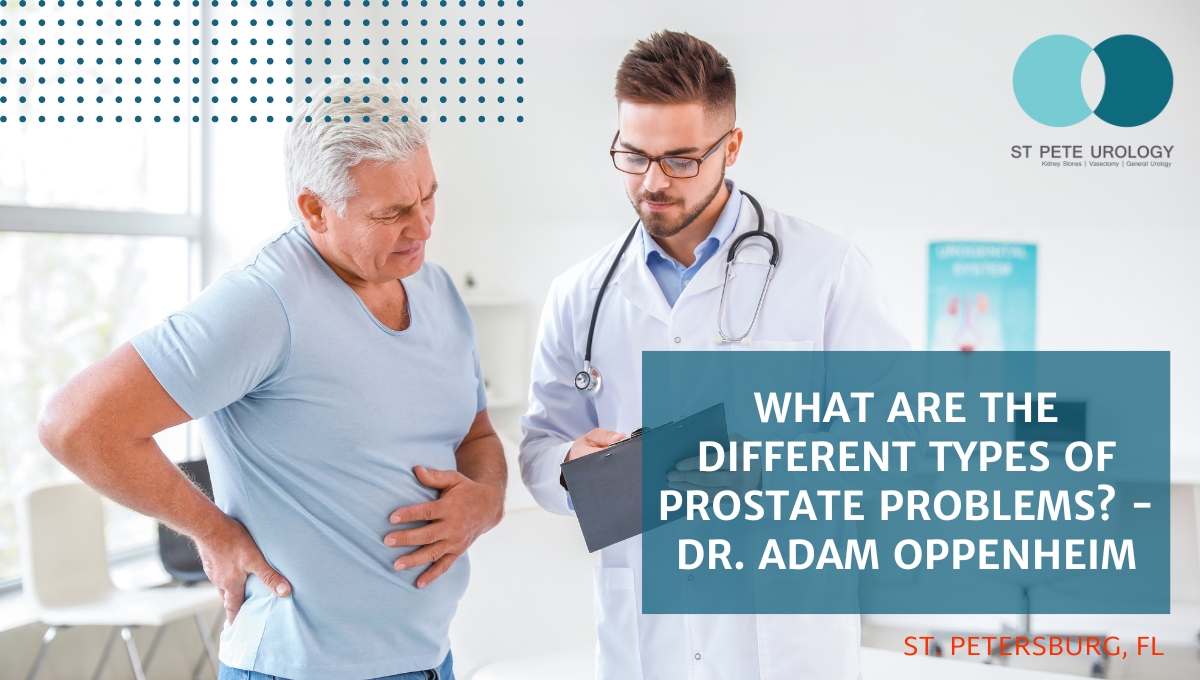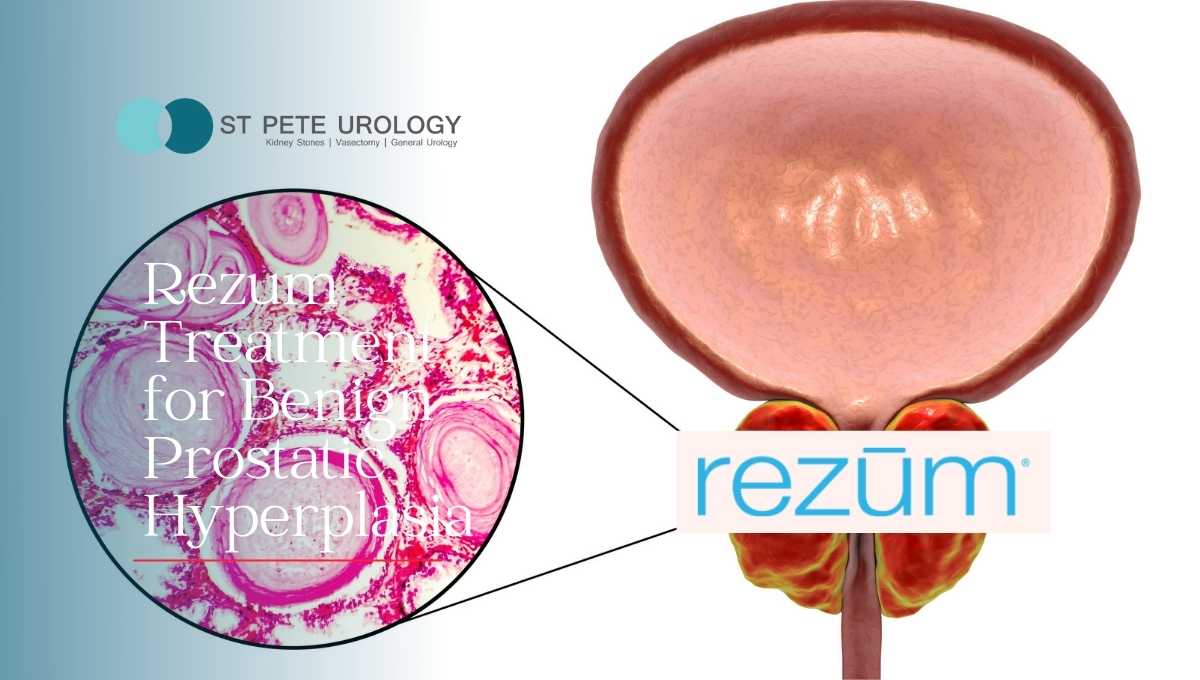How effective are non-surgical treatments for BPH? Understanding these treatments is a complex one, so find out more with St. Pete Urology.
Continue readingHow Does an Enlarged Prostate Affect Urinary Function?
How does an enlarged prostate affect urinary function? Getting UTI, bladder stones or kidney damage are just some possible symptoms.
Continue readingBPH (Enlarged Prostate): What Is It?
What is BPH or Enlarged Prostate? BPH is a condition that will affect the prostate of nearly every man at some point after the age of 40.
Continue readingUnderstanding Prostate Enlargement: Myths and Facts
How much of what you hear about prostate enlargement is true? Learn about the myths and misconceptions about prostate enlargement or BPH.
Continue readingProstate Enlargement: What Every Man Should Know
By the time you reach the golden age of fifty and beyond, it’s not uncommon to experience symptoms of an enlarged prostate. Learn more here.
Continue readingAdvancements in Men’s BPH Treatment: UroLift Technology by Dr. Reid Graves
Key Takeaways:
- The UroLift technology is a minimally invasive device that staples the lobes of the prostate apart from each other, allowing for a much quicker recovery experience without a catheter.
- The UroLift technology is the only device that does not have the side effect of retrograde ejaculation, making it a viable treatment option for men grappling with BPH.
- St. Pete Urology is a leading urology practice offering state-of-the-art BPH treatment options, including the UroLift technology. Their commitment to delivering the best care to their patients makes them a trustworthy option for pursuing BPH treatment.
Navigating the path of finding the right BPH treatment can be a labyrinthine task. Over the years, advancements have been made in the field, but with each progress comes a new set of challenges. That’s where the UroLift technology steps in. It is a minimally invasive device yoking the future of urology with the demands of the contemporary patient. Spearheading this revolution in BPH treatment is Dr. Reid Graves, a board-certified urologist based in St. Petersburg, FL.
Embracing New Technologies
Dr. Graves, of St. Pete Urology, eloquently elucidates how the UroLift technology is adding a groundbreaking dimension to urology. He says, “There have been new technologies that have recently come out with a device called the UroLift technology, which essentially is a stapling device that staples the lobes of the prostate apart from each other so that the patient can void through their prostate.”
This advanced device, in Dr. Graves’ own words, “is an exciting new advancement in the era of BPH treatment for a couple of reasons.” It’s minimally invasive technology with almost no blood loss. Moreover, patients can even return home without a catheter, dramatically enhancing their recovery experience.
Addressing Troubling Side Effects
Technological triumph is praiseworthy. However, the true gauge of new treatments is its capacity to relieve the side effects that previously afflicted patients. One such side effect, often linked with BPH treatment, is retrograde ejaculation. This occurs when the ejaculate reverses into the bladder during orgasm. It prevents patients from seeing their ejaculate during intercourse, a predicament that disturbs many men.
Fortunately, in the case of the UroLift device, as Dr. Graves informs us, “This new treatment, the UroLift device, is the only device which does not have this side effect.” This revelation solidifies UroLift’s standing as a viable treatment option for men grappling with BPH.
A Brighter Future for BPH Treatment
The advent of UroLift technology highlights the fact that even in a field as intricate as urology, there is always room for innovation. By creating a less invasive treatment option, the field of urology has proven its commitment to patient wellbeing once more.
Looking ahead, it’s clear that UroLift technology is leading the charge in transforming the face of BPH treatment. From its efficacy to the lack of troubling side effects, the device has emerged as a promising solution to an enduring problem.
Trust St. Pete Urology for Top-Notch Treatment
St. Pete Urology, a leading urology practice in St. Petersburg, Florida, continues to be at the epicenter of these advancements, offering state-of-the-art BPH treatment options. These include the groundbreaking UroLift technology, a testament to their commitment to delivering the best care to their patients.
Through the skilled guidance of Dr. Reid Graves, St. Pete Urology is creating a better tomorrow, one patient at a time. So, trust St. Pete Urology to guide you through the web of decisions. Their understanding, expertise, and dedication to patient care set them apart from the rest. This ensures that you receive the most targeted and effective BPH treatment.
References:
- “UroLift Procedure for BPH (Enlarged Prostate) – Overview and Cost.” https://www.urologysanantonio.com/bph-enlarged-prostate/urolift-procedure.
- “Benign Prostatic Hyperplasia (BPH) – Urology Care Foundation.” https://www.urologyhealth.org/urology-a-z/b/benign-prostatic-hyperplasia-(bph).
- “Retrograde ejaculation – Symptoms and causes – Mayo Clinic.” 11 Jan. 2022, https://www.mayoclinic.org/diseases-conditions/retrograde-ejaculation/symptoms-causes/syc-20354890.
Transcription:
Hi, I’m Dr. Reid Graves and I’m a board certified urologist at St. Pete Urology. There have been new technologies that have recently come out with a device called the UroLift technology, which essentially is a stapling device that staples the lobes of the prostate apart from each other so that the patient can void through their prostate. Now this is an exciting new advancement in the era of BPH treatment for a couple of reasons. One, it is extremely minimally invasive with almost no blood loss and patients can even go home without a catheter.
In addition, one of the most troubling side effects for men with treatment of BPH is retrograde ejaculation. This is when the ejaculate goes backwards into the bladder when a patient is having an orgasm and they’re unable to see their ejaculate during intercourse. This is often something that bothers men and this new treatment, the UroLift device, is the only device which does not have this side effect. And so this is something that is a new exciting advancement in this field.
Dr. Reid Graves on Effective Treatments for Enlarged Prostates at St Pete Urology
Key Takeaways:
- Treatments for enlarged prostates require careful consideration of various factors to create a personalized treatment plan.
- TURP and GreenLight laser treatments are effective methods of managing an enlarged prostate.
- St Pete Urology provides expert care and quick recovery times for prostate enlargement treatments.
As men age, they may face the common yet uncomfortable issue of prostate enlargement. In St. Petersburg, FL, there’s a urologist who understands the intricacies of this condition – Dr. Reid Graves of St Pete Urology. In his words, “One of the things we take pride in here at St. Pete Urology is the management of patients with enlarged prostates.” So, what makes his approach so effective? Let’s dive in and explore Dr. Graves’ effective treatments of enlarged prostates.
Determining the Best Treatment
Treating an enlarged prostate isn’t a one-size-fits-all approach. Instead, it requires careful consideration of various factors. These factors include the patient’s overall health, comorbid conditions, and potential complications from blood thinners, as explained by Dr. Graves. The goal, of course, is to create a personalized treatment plan that best suits each patient’s needs.
TURP and GreenLight Laser: Two Effective Treatment Options
There are many different treatment options available for managing an enlarged prostate. Two of the most effective methods, according to Dr. Graves, are TURP (transurethral resection of the prostate) and GreenLight laser prostatectomy.
TURP involves the use of a hot knife that is inserted through the urethra to cut out pieces of tissue from the prostate. This procedure can be invasive, but it often produces excellent results for patients with severe urinary symptoms or obstruction.
Alternatively, Dr. Graves also recommends the GreenLight laser prostatectomy. This procedure is unique because the laser used is absorbed by hemoglobin in the blood. This minimizes blood loss during surgery. Interestingly, Dr. Graves can perform this treatment on patients taking blood thinners. This makes it a versatile option for many men dealing with prostate enlargement.
The “Apple Core” Analogy
To help his patients understand the goals of these treatments, Dr. Graves uses the analogy of an apple. Imagine the prostate as an apple, and the core is the part where urine travels through. In order to improve a patient’s ability to urinate, the “apple core” must be removed to create more space for the urine to pass. Both TURP and GreenLight laser procedures can effectively achieve this goal by removing excess tissue from the prostate with precision and care.
Quick Recovery Times
One of the most striking aspects of Dr. Graves’ treatment methods is the speedy recovery time. With the GreenLight laser prostatectomy, patients can expect to have their catheter removed the day after the procedure, and it could even be a same-day surgery. This quick turnaround allows men to return to their regular activities with minimal disruption, making it an attractive option for those seeking relief from their prostate enlargement symptoms.
Choose St Pete Urology for Expert Care
If you or a loved one are dealing with the challenges of prostate enlargement, it’s crucial to find a skilled and compassionate urologist who will prioritize your needs and well-being. In St. Petersburg, FL, Dr. Reid Graves and the team at St Pete Urology are known for their dedication to providing the highest level of care to patients facing this common yet complex condition. Don’t leave your health in the hands of just anyone – trust the experience and expertise of St Pete Urology to guide you toward the most effective treatments for enlarged prostates.
References:
- “Transurethral Resection of the Prostate (TURP).” https://www.hopkinsmedicine.org/health/treatment-tests-and-therapies/transurethral-resection-of-the-prostate-turp.
- “What Is A GreenLight Laser Prostatectomy? | QProstate.” https://qprostate.com.au/greenlight-laser-prostatectomy/greenlight-laser-prostatectomy/.
- “Enlarged Prostate (BPH) – Symptoms and Causes – Penn Medicine.” https://www.pennmedicine.org/for-patients-and-visitors/patient-information/conditions-treated-a-to-z/enlarged-prostate.
Transcription:
My name is Reid Graves and I’m a urologist at St Pete Urology. One of the things we take pride in here at St. Pete Urology is the management of patients with enlarged prostates. This is a very common problem as men age and oftentimes people will have difficulty urinating. If their symptoms are significant enough or they’re unable to urinate, oftentimes a surgery will be indicated. Determining which surgery is right for the patient depends on a variety of factors including their comorbid conditions, their health, and if they’re on any blood thinners. Some of the options include a TURP or transurethral resection of the prostate in which a hot knife is used through the urethra in order to cut out the pieces of the tissue in the prostate.
Another option is to use the GreenLight laser to perform a GreenLight laser prostatectomy. This laser is unique because the laser is absorbed by hemoglobin which is in the blood. This provides the patient with minimal blood loss during the procedure and we’re actually able to perform these procedures in patients that are on blood thinners. Essentially when patients have enlarged prostates, the prostate is like an apple. The apple core is the part where the urine travels through the apple. In order for us to allow patients to urinate better, we use our instruments to remove the apple core from the apple so that the urine can flow through the apple. We can use the GreenLight laser to perform this with a same day procedure or at the most patients will stay overnight one day and then we will remove their catheter the following day.
What Are the Different Types of Prostate Problems? – Dr. Adam Oppenheim
Key Takeaways:
- There are two main types of prostate problems: Benign Prostatic Growth and Prostate Cancer.
- Early detection is key in managing and treating prostate cancer and should begin at age 50 (or 45 for those with a family history or higher risk factors).
- Treatment for both benign prostatic growth and prostate cancer depends on various factors and should be personalized to meet each patient’s unique needs.
Getting to Know Your Prostate
As the wise Dr. Adam Oppenheim says, “I’m a urologist with St. Pete Urology.” And who better to enlighten us on the different types of prostate problems than a seasoned professional? So, sit back and let’s delve into the world of prostate health.
First, let’s begin with some basics. The prostate is a walnut-sized gland located just below the bladder in men. Its primary function is to produce the fluid that nourishes and transports sperm. While this may seem like a small and insignificant part of the male anatomy, it can cause significant problems if not properly cared for.
Two Main Types of Prostate Problems
Dr. Oppenheim outlines two main issues in urology related to the prostate:
- Benign Prostatic Growth
- Prostate Cancer
Let’s take a closer look at each of these issues.
Benign Prostatic Growth: When Nature Takes Its Course
As Dr. Oppenheim explains, benign prostatic growth occurs when “patients have trouble urinating and they’re very bothered and often have to urinate very frequently or have a blocked stream.” This condition is known as Benign Prostatic Hyperplasia (BPH) and is a natural part of the aging process for men.
However, the symptoms of BPH can be quite bothersome, including:
- Frequent urination
- Difficulty starting and stopping urination
- Weak urine stream
- Dribbling of urine
While BPH is not life-threatening, it can significantly impact a man’s quality of life. Treatment options vary depending on the severity of symptoms and may include medications, minimally invasive procedures, or surgery.
Prostate Cancer: The Silent Threat
The second issue, prostate cancer, is a more sinister problem. Dr. Oppenheim informs us that “it doesn’t usually cause symptoms, but it can cause life-threatening cancer down the road if not treated.” This type of cancer occurs when malignant cells begin to grow uncontrollably in the prostate gland, often without any noticeable symptoms.
Early detection is key in managing and treating prostate cancer. Dr. Oppenheim suggests that men should begin screening for prostate cancer at age 50 (or 45 for those with a family history or higher risk factors). Regular screening tests, such as a prostate-specific antigen (PSA) blood test and digital rectal exam (DRE), can help identify any abnormalities in the prostate gland.
Choosing the Right Path: Customized Treatment Options for Prostate Problems
The course of treatment for both benign prostatic growth and prostate cancer depends on various factors, including the severity of the condition, age, overall health, and personal preferences. Dr. Oppenheim and the experts at St. Pete Urology offer personalized treatment plans designed to meet each patient’s unique needs.
For BPH, treatment options may include medication management, minimally invasive procedures, or surgery. For prostate cancer, treatment options can range from active surveillance (monitoring) to radiation or surgery, depending on the stage and aggressiveness of the cancer.
Conclusion: Trusting Your Prostate Health to St Pete Urology
Dr. Adam Oppenheim and the team at St Pete Urology in St Petersburg, Florida, understand the importance of early detection and customized treatment plans for men dealing with prostate problems. As Dr. Oppenheim says, “prostate health is a vital component of overall well-being, and we are here to help you navigate the complexities of this often-misunderstood aspect of men’s health.”
Don’t leave your prostate health to chance. Trust the urology professionals at St Pete Urology to provide the expertise and compassionate care you need. Schedule an appointment today and take control of your prostate health.
References:
- “Prostate disease – Better Health Channel.” https://www.betterhealth.vic.gov.au/health/conditionsandtreatments/prostate-disease.
- “Benign Prostatic Hyperplasia (BPH) – Urology Care Foundation.” https://www.urologyhealth.org/urology-a-z/b/benign-prostatic-hyperplasia-(bph).
- “Prostate Cancer: Types of Treatment.” https://www.cancer.net/cancer-types/prostate-cancer/types-treatment.
Transcription:
I’m Dr. Adam Oppenheim, I’m a urologist with St. Pete Urology.
So the prostate, there’s kind of two main issues in urology with the prostate.
There’s benign prostatic growth where patients have trouble urinating and they’re very bothered and often have to urinate very frequently or have a blocked stream.
And then there’s prostate cancer which is different and that doesn’t usually cause symptoms but it can cause life threatening cancer down the road if not treated.
The Role of Stress in Prostate Enlargement: What You Need to Know
Key Takeaways:
- Stress can lead to an enlarged prostate due to increased levels of hormones and a decrease in zinc levels.
- The release of adrenaline due to stress can cause the bladder and prostate to shut down, resulting in more difficult and painful urination.
- Managing stress through lifestyle and behavioral changes such as exercise, sleep and therapy can help prevent prostate enlargement and ease its symptoms.


Its primary function is to secrete an alkaline fluid that adds to the bulk of semen—a mixture of seminal, bulbo-urethral, and prostatic fluid.
With its sphincter muscles, the prostate seals off the entry from the bladder into the urethra, preventing the flow of urine during sexual intercourse. Plus, it contains muscles that help to expel semen out of the penis during sexual intercourse.
Hormone-dependent enlargement
The prostate doesn’t remain tiny for life. It undergoes two phases of hormone-dependent growth: the first at puberty when it nearly doubles its size, and the second after 25 years and for the rest of life.
Now, the prostate requires testosterone to function. But it also contains the enzyme 5-alpha reductase, which converts testosterone to dihydrotestosterone (DHT).
DHT is responsible for development of various male characteristics, such as facial hair. And it equally promotes the enlargement of the prostate.
In fact, if you live long enough, the increased levels of DHT will ensure a continued growth of the gland until you have a condition called an enlarged prostate.
Also called BPH (benign prostatic hyperplasia), an enlarged prostate is a condition where the gland has grown large enough to press or pinch the urethra and cause urinary symptoms.
It occurs in roughly 30% of men over 50 years and in 90% of men aged 80 years.
What is the role of stress in an enlarged prostate?
Stress and BPH are highly related. In fact, the more stressed you become, the worse your BPH symptoms get. And the worse your BPH symptoms get, the more stressed you feel. It is an endless cycle.
But how is stress related to prostate enlargement?
And what should you know about that relationship?
- Stress affects hormones that trigger prostate enlargement
When your body is stressed, it releases more of the cortisol hormone. In men, cortisol suppresses other key hormones such as testosterone.
Now, as your level of testosterone drops, the level of estrogen increases. And the increased level of estrogen indirectly promotes the growth of prostate cells, resulting in an enlarged prostate.
Also, stress increases the rate of conversion of testosterone to dihydrotestosterone (DHT). When an increased level of DHT accumulates in the prostate, it triggers rapid cell growth and development.
While low levels of DHT may not cause an enlarged prostate, a very high level resulting from extreme, prolonged stress eventually causes prostate enlargement.
Actually, DHT is the central hormone responsible for the growth of the prostate both in puberty and young adulthood. Hence, increased levels of DHT due to stress are an important factor in prostatic enlargement.
- Stress depletes zinc
Stress usually causes body zinc levels to reduce significantly.
Zinc is a critical mineral for the prostate, controlling the gland’s rate of expansion. It occurs more commonly in the prostate than in any other human tissues.
So when zinc deficiency occurs due to prolonged stress, the prostate gland enlarges rapidly, resulting in an enlarged prostate.
If you already have BPH, then reduced zinc levels tend to worsen its symptoms.
By reducing stress and eating zinc-rich foods, such as pumpkin seeds, you can boost your body zinc levels, prevent rapid growth of the prostate, and ease BPH symptoms.
- Stress promotes adrenaline secretion
When your body is in a stressful situation, it gets into a ‘flight or fight’ mode that triggers the release of increased quantities of adrenaline.
The adrenaline triggers contraction of muscles of the prostate and bladder. As a result, the prostate compels the urethra to narrow, making passing urine more difficult and painful.
Also, the released adrenaline may cause the bladder to effectively ‘shut down’, worsening urinary symptoms.
So stress is bad for you if you already have an enlarged prostate. It elevates the amount of adrenaline in your body, which impacts both the bladder and prostate and worsens BPH symptoms.
- Stress increases tension in pelvic floor muscles
Lastly, when stressed, your pelvic floor muscles become tenser. And the tightening of these muscles forces the urethra to narrow.
In turn, this makes urine flow more difficult. Hence, if you already have an enlarged prostate, your symptoms become worse.
Prompt management of stress for BPH
If you have an enlarged prostate, it is important that you avoid or minimize stress. Speak about things that are stressing you or causing anxiety and depression with friends, family, or a therapist.
Also, consider lifestyle and behavioral changes to manage stress, including regular aerobic exercise, adequate sleep, and practicing yoga and meditation.
At St Pete Urology, we encourage healthy habits such as avoiding caffeine and minimizing fluid intake a few hours before bedtime. We also recommend speaking with a licensed therapist and joining a support group to help you with stress.
And for those with severe symptoms of an enlarged prostate, we recommend seeing a urologist for treatment to bring the symptoms under control. After that, you may only need annual checkups.
For more information on prevention, diagnosis, and treatment of benign prostatic enlargement and other urological problems, visit the site “St Pete Urology.”
References:
- “Benign Prostatic Hyperplasia (BPH).” Urology Health, Urology Health, www.urologyhealth.org/urology-a-z/b/benign-prostatic-hyperplasia-(bph).
- “Dihydrotestosterone.” Your Hormones, www.yourhormones.info/hormones/dihydrotestosterone/.
- “Enlarged Prostate.” Healthline, Healthline Media, www.healthline.com/health/enlarged-prostate.
- “Prostate Enlargement.” National Health Service, National Health Service, www.nhs.uk/conditions/prostate-enlargement/treatment/.
Rezum Treatment for Benign Prostatic Hyperplasia
Benign prostatic hyperplasia (BPH), also called enlarged prostate, is a frustrating condition commonly occurring as men grow older.
Continue reading
